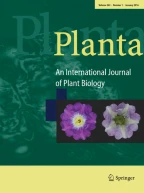Summary
Tillandsia usneoides, in the common sense a non-succulent plant, exhibits CO2 exchange characterized by net CO2 dark fixation during the night and depression of CO2 exchange during the day. Malate has been demonstrated to accumulate during CO2 dark fixation and to be converted to carbohydrates in light. Thus, T. usneoides exhibits CAM like typical succulents.
Net CO2 uptake during the day is increased with net CO2 output being suppressed in duration of time and extent when light intensity increases. Furthermore, a slight increase in CO2 fixation during the following night can be observed if the plants were treated with high light intensity during the previous day.
Curves of CO2 exchange typical for CAM are obtained if T. usneoides is kept at 15°C and 20°C. Lower temperature tend to increase CO2 uptake during the day and to inhibit CO2 dark fixation. Temperatures higher than 20°C favour loss of CO2 by respiration, which becomes apparent during the whole day and night at 30°C and higher temperatures. Thus, T. usneoides gains carbon only at temperatures well below 25°C.
Net CO2 uptake during the day occurs only in moist plant material and is inhibited in plants cept under water stress conditions. However, CO2 uptake during the night is clearly favoured if the plants dry out. Therefore dry plants gain more carbon than moist ones.
Curves of CO2 exchange typical for CAM were also obtained with 13 other species of the genus Tillandsia.
The exhibition of CAM by the non-succulent T. usneoides calls for a new definition of the term “succulence” if it is to remain useful in characterizing this metabolic pathway. Because CO2-fixing cells of T. usneoides possess relatively large vacuoles and are relatively poor in chloroplasts, they resembles the assimilatory cells of typical CAM-exhibiting succulents. Therefore, if “succulence” only means the capacity of big vacuoles to store malate, the assimilatory cells in T. usneoides are succulent. It seems to be useful to investigate parameters which would allow a definition of the term “succulence” on the level of the cell rather than on the level of the whole plant or plant organs.
Similar content being viewed by others
Literatur
Benzing, D. H., Renfrow, A.: Significance of the pattern of CO2 exchange to the ecology and phylogeny of the Tillandsioideae (Bromeliaceae). Bull. Torrey Bot. Club 98, 322–327 (1971).
Biebl, R.: Zum Wasserhaushalt von Tillandsia recurvata L. und T. usneoides L. auf Puerto Rico. Protoplasma (Wien) 58, 345–368 (1964).
Bieleski, R. L., Turner, N. A.: Separation and estimation of amino acids in crude plant extracts by thin layer electrophoresis and chromatography. Analyt. Biochem. 17, 278–293 (1966).
Brandon, P. C.: Temperature features of enzymes affecting Crassulacean Acid Metabolism. Plant Physiol. 42, 977–984 (1967).
Coutinho, L. M.: Novas observacoes sobre a occorencia do “effeito de DeSassure” e suas relaco es com a suculencia, a temperature folhear e os movimentos estomáticos. Botanica 27, 77–102 (1969).
Kluge, M.: Untersuchungen über den gaswechsel von Bryophyllum während der Lichtperiode. I. Zum Problem der CO2-Abgabe. Planta (Berl.) 80, 255–263 (1968, a).
Kluge, M.: Untersuchungen über den Gaswechsel von Bryophyllum während der Lichtperiode. II. Beziehungen zwischen dem Malatgehalt des Blattgewebes und der CO2-Aufnahme. Planta (Berl.) 80, 359–377 (1968, b).
Kluge, M.: Veränderliche Markierungsmuster bei 14CO2-Fütterung von Bryophyllum tubiflorum zu verschiedenen Zeitpunkten der Hell/Dunkel-Periode. I. Die CO2-Fixierung unter Belichtung. Planta (Berl.) 88, 113–129 (1969).
Kluge, M.: Veränderliche Markierungsmuster bei 14CO2-Fütterung von Bryophyllum tubiflorum zu verschiedenen Zeitpunkten der Hell/Dunkel-Periode. II. Beziehungen zwischen dem Malatgehalt des Gewebes und dem Markierungsmuster nach 14CO2-Lichtfixierung. Planta (Berlin) 98, 20–20 (1971).
Kluge, M.: Die Sukkulenten: Spezialisten im CO2-Austausch. Biologie in unserer Zeit 2, 120–128 (1972).
Kluge, M., Fischer, K.: Über Zusammenhänge zwischen dem CO2-Austausch und der Abgabe von Wasserdampf durch Bryophyllum daigremontianum. Planta (Berl.) 77, 212–223 (1967).
Lange, O. L.: Der CO2-Gaswechsel von Flechten bei tiefen Temperaturen. Planta (Berl.) 64, 1–19 (1965).
Lange, O. L., Koch, W., Schulze, E. D.: CO2-Gaswechsel und Wasserhaushalt von Pflanzen in der Negev-Wüste am Ende der Trockenzeit. Ber. dtsch. bot. Ges. 82, 39–61 (1969).
Mc. Williams, E.: Comparative rates of dark CO2 uptake and acidification in the Bromeliaceae, Orchidaceae, and Euphorbiaceae. Bot. Gaz. 131, 285–290 (1970).
Nuernbergk, E. L.: Endogener Rhythmus und CO2-Stoffwechsel bei Pflanzen mit diurnalem Säurerhythmus. Planta (Berl.) 50, 28–70 (1961).
Nuernbergk, E. L.: Temperatur und Kohlendioxid-Stoffwechsel bei Bryophyllum daigremontianum. Port. Acta biol. A 6, 298–358 (1962).
Rauh, W.: Bromelien für Zimmer und Gewächshaus, Bd. 1, die Tillandsioideen. Stuttgart: E. Ulmer 1970.
Stocker, O.: Der Wasserhaushalt ägyptischer Wüsten- und Salzpflanzen. Botan. Abh. (Jena) 13, 200 S. (1928).
Thompson, F. B., Leyton, L.: Method for measuring the leaf surface area of complex shoots. Nature (Lond.) 229, 572 (1971).
Ting, I. P.: Nonautotrophic CO2 fixation and Crassulacean Acid Metabolism. In: Hatch, Osmond and Slatyer (eds.): Photosynthesis and photorespiration. Wiley-Interscience. New York-London-Syndey-Toronto (1971).
Wolf, J.: Der diurnale Säurerhythmus. In: Ruhland, W. (Hrsg.) Handbuch der Pflanzenphysiologie, Bd. XII/2. Berlin-Göttingen-Heidelberg: Springer 1960.
Author information
Authors and Affiliations
Rights and permissions
About this article
Cite this article
Kluge, M., Lange, O.L., Eichmann, M.v. et al. Diurnaler Säurerhythmus bei Tillandsia usneoides: Untersuchungen über den Weg des Kohlenstoffs sowie die Abhängigkeit des CO2-Gaswechsels von Lichtintensität, Temperatur und Wassergehalt der Pflanze. Planta 112, 357–372 (1973). https://doi.org/10.1007/BF00390308
Received:
Issue Date:
DOI: https://doi.org/10.1007/BF00390308
